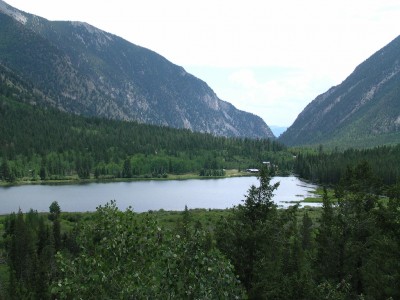Ontarios feed-in-tariff program needs to include geothermal
Canada needs to include geothermal energy into its renewable energy mix and needs to step up efforts to support it, e.g. in the case of Ontaria that needs to include geothermal into its feed-in-tariff scheme.
In an article by Milan Seres in Obiter Dicta, Toronto’s Osgoode Hall Law School, the point is made that Canada needs to step up its support for geothermal energy in renewable incentive programs, such as the Ontario Feed-in-Tariff.
One of the ways in which to make Ontario’s FIT program successful is to create an environment of stability and continuity within the policy framework. For example, the German framework has been regarded as successful because it has created a high level of investor certainty; in the case of Ontario, this would mean creating an environment suitable for continued project-level investment in renewable energies, especially those that are explicitly listed in the Green Energy Act. Investors researching renewable energy investment opportunities are going to be negatively influenced when a statute and policy within the mandates of that statute are inconsistent.
The objectives of the Ministry of Energy and Infrastructure include increasing the availability of renewable energy in Ontario and to increase the source of renewable energy sources in Ontario. The Ministry of Energy and Infrastructure Act continues by indicating that a further objective of the ministry is to stimulate the development of renewable sources of energy. This would include geothermal as it is defined as renewable energy under the Act.
The Feed-in Tariff Program was established through the Green Energy and Green Economy Act (GEGEA). The preamble of the GEGEA explicitly provides for the commitment by the Ontario government to foster the growth of renewable energy projects. This is followed by a commitment to remove barriers and promote the opportunities for renewable energy projects. The GEGEA defines what is considered as renewable energy under the Act. Within this definition, geothermal is included as a renewable energy source.
In accordance with the FIT directive addressed to the OPA, the objectives of the FIT program include increasing the capacity of renewable energy supply to ensure adequate generation and reduce emissions. Geothermal would not only increase the capacity of renewable energy supply in ensuring adequate generation through its base-load capabilities, but is also an emission free source of sustainable renewable energy. Another objective of the FIT program is to provide incentives for investment in renewable energy technologies. Geothermal was excluded from the scope of the FIT program, which significantly deters investment into this clean and sustainable renewable energy source in Ontario.
The FIT directive provides that the FIT program will be open to technologies that produce electricity from renewable sources; however, under the standard definitions of the FIT contract, geothermal was not listed as a renewable fuel. This is due to a definitional distinction between “renewable generating facility” (as per the FIT definition) and “renewable energy generation facility” (as per all other relevant and governing legislation). This is an attempt at creating a distinction without a difference that undermines the objectives of the GEGEA.
Ontario’s Long-Term Energy Plan recognizes that a diverse supply mix is needed. Geothermal is more than capable of being a part of such a mix. Its base-load capacity is an integral reason as to why this is the case. A medium demand energy growth scenario is being used; however, the plan must also have the flexibility in which to accommodate the potential of a higher growth outcome. Geothermal is able to solve the problem of not having power when needed to accommodate these changes at any time.
Ontario’s current electricity generation capacity from gas-fired power plants is over 9500 MW. The role natural gas is to play in Ontario is to support the intermittent supply from renewables such as wind and solar, meet local and system reliability requirements, and ensure adequate capacity is available as nuclear plants are being modernized. Geothermal power is capable of fulfilling the same strategic role.
The Ontario Power Authority explicitly indicates that there will be a capacity gap with the removal of coal and indicates a reliance upon gas-fired generation to fill that void. Geothermal may be used as a supplement to minimize that capacity gap.
The Supply Mix Directive considers the availability of importing electricity from other jurisdictions. The electricity coming from other jurisdictions, most notably the United States, comes from coal power plants. The use of geothermal can aid in reducing the amount of electricity needed to import even in times of peak demand, since it is a base-load power source. The more base-load power Ontario has, the less we need to rely on importing from such power sources which reduces Ontario’s air quality. Moreover, the development of base-load power opportunities in Ontario increases the province’s energy security.
The Supply Mix Directive calls for a plan for remote community connections, and is to consider the possibility of interim off-diesel solutions. The value of having base-load power production anywhere through geothermal is the potential to eliminate diesel fuel powered generation. Intermittent renewables may still be developed, but the use of a clean base-load power supply would negate the problems and costs associated with diesel generation. Geothermal is a solution to these problems as a base-load renewable energy source.
There is emphasis by the Ontario government to include aboriginal communities as partners in FIT projects. Geothermal power production can be a valuable addition for aboriginal communities, in remote areas or otherwise, to build capacity in energy and generate income. Currently, First Nation communities rely upon diesel generation for their electricity supply or as a back-up. Diesel fuel is expensive, difficult to transport, and poses environmental and health risks. These remote communities would benefit greatly from geothermal as a base-load power provider as it is capable of overcoming the numerous problems behind diesel generation for onsite generation.
The duty to consult with Aboriginals is also undermined when aboriginal communities are artificially limited in their options to develop renewable energy projects. Remote communities would benefit greatly from a base-load power source that can eliminate diesel fuel as a source of power. Another significant advantage is the potential to develop greenhouses using the heat from geothermal sources in northern communities. Geothermal power generation combined with the ability to harness the heat from these sources places geothermal at a greater advantage than other renewables. It is possible for a remote community to not only power their homes and businesses, but also have additional agricultural capabilities as a result of geothermal power.
Furthermore, the Green Energy Act is to be administered in a manner that promotes community consultation. Any sort of consultation must be pursued in a meaningful manner, which is having the necessary information available to make an informed decision. The failure to include geothermal in the FIT program limits public awareness on a renewable energy source that is explicitly provided for in legislation. Essentially, the conception of good faith negotiations is undermined as a result of geothermal exclusion. This is consistent with section 25.32(4.4) of the Electricity Act, which speaks to consultation in not only the procurement of electricity supply, but planning as well. A Community Energy Plan under the Aboriginal Energy Partnerships Program is less effective when local interests, needs, and opportunities are assessed absent from the consideration of geothermal projects.
The OPA is set to develop a standard offer program for combined heat and power projects (CHP). This provides another opportunity to support geothermal power generation since geothermal heating is already evident in Ontario. The technology behind geothermal power generation is already being used for heating and cooling in many areas, including downtown Toronto. Ontario has a target of 1000 MW of CHP cogeneration. Cogeneration of both electricity and heat from geothermal sources would be able to satisfy Ontario’s demand for the CHP cogeneration, with less reliance on gas-fired plants to meet the 1000 MW target. As indicated, the additional value of geothermal is the heating advantages that can be used by remote or northern communities for various purposes, such as residential heating or greenhouses. This can eliminate the reliance on fuel imports for power and heating.
Ontario is planning on focusing on localized generation from smaller, cleaner sources, rather than large centralized plants. Another value of geothermal power generation is that it is scalable. The distributed generation qualities of geothermal are able to promote Ontario’s plan, including the use in remote communities in both large and small scale projects.
Well functioning feed-in tariff mechanisms are calculating the tariffs based on the technology specific generation costs. In order to do so, the legislator needs to analyze the costs for renewable power generation based on a large number of costs components, including investment costs (together with material and capital costs), grid-related and administrative costs (grid connection cost, costs for the licensing procedure, and so on), operation and maintenance costs, and fuel costs (bioenergy, for example).
The focus must be on the promotion of environmentally safe power generation and the development of a renewable energy industry. This focus must be made primarily with the long-term impacts in mind. When cost is assessed on short-term objectives, then there will naturally be an inherent bias for solutions that have lower start-up costs. While the cost of a new geothermal power generation facility is higher than that of a comparable natural gas facility, the two are similar over time. Natural gas construction costs account for only one third of the total price of the facility, while the cost of the fuel at a natural gas facility represents two thirds of the cost. The initial construction costs of a geothermal facility, in contrast, represent two thirds or more of total costs. So although initial investment is high for geothermal, natural gas and geothermal are still economically comparable over the lifetime of the geothermal power generation facility. This does not even speak to the commodity pricing fluctuations under which natural gas-fired plants operate. Geothermal would not be subject to the price volatility experienced in energy sources with fuel costs, since the source itself is where the generation facility is located.
One option is to create a front-end loaded tariff payment schedule for geothermal energy production in which to encourage even more investment due to the greater up-front costs. These may then be tapered down over time in order to accommodate the low maintenance cost in running the facility. Pricing may even be reduced under new carbon market regulations
Furthermore, with regard to cost, geothermal does not require a transportable fuel source; consequently, there is no need to develop a pipeline infrastructure to accommodate such power generation. Another advantage of geothermal power generation is that it uses less land than any other energy source, including both fossil fuel and renewable sources.
The Long-term Energy Plan provides for the expansion of the transmission system to allow for the inclusion of renewables. The intermittent nature of certain renewables requires that the transmission system be updated to deal with such power sources. Geothermal would not need the same system in place as intermittent renewables.
Geothermal should be considered in the expansion and upgrading of existing facilities. The partial conversion of decommissioned coal facilities is possible. Furthermore, the possibility for cogeneration with gas-fired plants, and even a supplement to biomass generation at such facilities, is another opportunity for geothermal projects. The potential for using existing equipment, infrastructure, and wells in such locations merely enhances the prospects for geothermal projects in Ontario.
Hidden costs, including land degradation, detrimental air emissions, and other health impacts to humans are virtually non-existent with geothermal power production. This cannot be said of other forms of power generation, such as natural gas. Instead of hidden costs, geothermal often has unrecognized benefits.
Finally, there are numerous green jobs that are also created in Ontario as a result of investments made in geothermal. Jobs are created at various stages of geothermal development including project start-up, exploration, drilling, plant design and construction, manufacturing, operation, and maintenance. Geothermal projects by Canadian Geothermal Energy Association (CanGEA) members alone represents nearly 11,500 full and part-time jobs and is equivalent to more than 10 gigatonnes per year of offset carbon emissions.
It is critical to acknowledge that the geothermal power generation industry is not limited to areas along the “Pacific Ring of Fire.” This is not a Western Canada industry. Geothermal is not limited to areas with volcanic systems. The activities of the oil industry in Ontario has revealed hot sedimentary aquifers and the mining industry has found deep heat areas as consistent with the development of enhanced geothermal systems. Mining, oil, and gas experience can play a valuable part in the development of geothermal projects in the province, particularly as it provides overlapping know-how and experience. What is lacking in Ontario is the creation of a map indicting potential geothermal power production sites. Exploration data or detailed maps of significant geothermal resources are required. Governmental support would drive the efforts for a greater informational basis for evaluating geothermal resources in the province. There are entrepreneurs who would develop a map; however, such development is conditional upon the inclusion of geothermal in the FIT program. The pursuit of geothermal opportunities in Ontario is subject to the investment environment that the province creates. As indicated, a consistent legislative environment would allow for the creation of a map that would substantiate the basis for geothermal development in Ontario. To exclude geothermal from the FIT program is to disregard the thriving geothermal industry in other parts of the world (such as Germany and Australia) that have a similar non-volcanic geology like Ontario and have included geothermal in its respective FIT program.
Renewables that include wind, solar, and bio-energy are projected to produce 10,700 MW. This target may become even more ambitious with the inclusion of geothermal, which in turn is able to reduce reliance on fossil fuels. Expanding technological eligibility in the FIT program for a renewable energy source that is technically feasible, cost-effective, and explicitly provided for in legislation can only help Ontario develop its renewable energy industry and become a global leader.
Source: Obiter Dicta via CanGEA


















